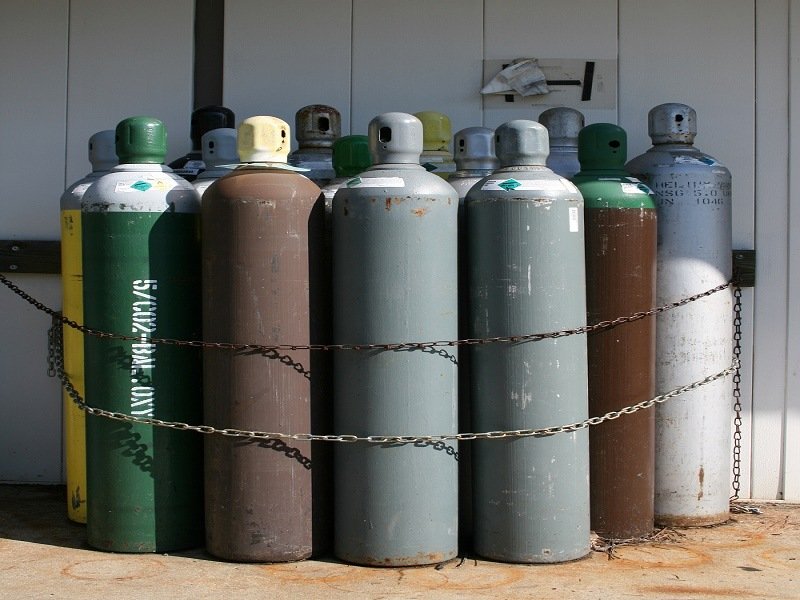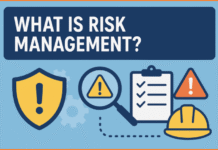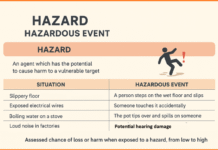Contents
Pressure hazard
With pressure, hazards may occur as a result of equipment failure and leakage from system that are not pressure tight. Improper pressure control may cause unsafe reaction rates.
Diffusivity
Diffusion of leaking gases may causes rapid contamination of the atmosphere, giving rise to toxicity, anaesthetic effects, asphyxiation and rapid formation of explosive concentrations flammable gases.
Flash point
The flash point of the flammable gas under pressure is always lower than ambient or room temperature. Leaking gas can therefore rapidly from an explosive mixture air.
Low boiling point
Gases with low boiling point can cause frostbite on contact with lining tissue. This is common among the cryogenic liquid such as nitrogen and oxygen, but it also can result from contact of the liquid phase of liquefied gases, such as carbon dioxide, fluorocarbons, and propylene.
Hazardous properties of compressed gases
- Flammability
- Toxicity
- Chemical activity
- Corrosive effects
The commercial fuel gases have one common property. They all require oxygen to supports combustion. A fuel gas when burned with oxygen must have-
- High flame temperature
- High rate of flame propagation
- Adequate heat content
- Minimum chemical reaction of the flame with base and filler metals in order to be used for welding operations.
Acetylene and hydrogen are the only available fuel gases which possess all the desired properties. Other gases such as propane and natural gas have sufficiently high flame temperature but have low flame propagation rates.
| Name of GAS | Ignition temp. Of atmospheric pressure | Limits of flammable in percentage by volume at atmospheric pressure and room temperature | ||||
| In air | In oxygen | |||||
| In oxygen | In air | Lower | Upper | Lower | Upper | |
| Acetylene | 781-824 | 763-824 | 2.5 | 80.0 | 2.8 | 93.00 |
| Methane | 1033-1292 | 1202-1382 | 5.0 | 15 | 5.4 | 59.2 |
| Ethane | 968-1166 | 968-1166 | 3.2 | 12.4 | 4.1 | 50.5 |
| Propane | 914-1058 | 960-1100 | 2.4 | 9.5 | – | – |
| Butane | 1130 | 920-1070 | 1.9 | 8.4 | – | – |
| Hydrogen | 1076-1094 | 1076-1094 | 4.0 | 74.2 | 4.7 | 93.9 |
Acetylene Cylinder
- Leak surrounding the valve stem
If a leak of Acetylene gas is found around the steam when the valve of an Acetylene cylinder is opened, closed the valve and tighten the gland nut. If this procedure does not stop the leak, discontinue the use cylinder and place it out-of-doors. Tag the cylinder as defective inform the supplier.
- Leak from the cylinder valve
If the acetylene cylinder leaks from the cylinder valve, it cannot be shut off with the valve stem. So take the cylinder out of doors, tag it as defective and notify the supplier. Although leakage may be temporarily stopped by connecting a regulator to a leaky valve, warning signs should be posted, requesting that lighted cigarettes and other sources of ignition be kept away.
- Leak at cylinder’s fusible plug
If the leak developed near the fusible plug of the cylinder, move the cylinder out of doors and place it away from any source of ignition. Open the cylinder valve slightly and allow the acetylene to escape slowly. A warning sign should be pasted.






Air is a mixture of gases (78% nitrogen, 20.9 % Oxygen and other gases.
Oxygen is pure gas
Thanks Sir hazardous of compressor gas about but what different between in air and in oxygen